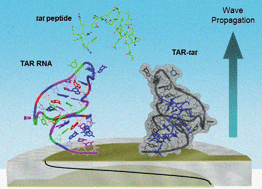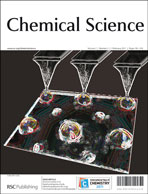Material properties, interfacial slip, and conformational changes are modelled for the immobilisation of HIV-1 TAR RNA and subsequent binding of tatpeptide fragments to the surface of a transverse-shear mode acoustic wave device. The modelling is based on previously-reported experimental results [N. Tassew, Ph.D. Thesis, 2003, University of Toronto, Toronto, Canada] and follows on from a previous modelling paper [J. S. Ellis and M. Thompson, Langmuir, 2010, 26, 11558]. A three-layer shear acoustic model is used to represent the system, where the layers describe the biomolecular monolayers and the contacting bulk buffer solution. Each layer is described by geometric, viscoelastic, and interfacial parameters, which are numerically fit to experimental values using a two-parameter minimisation algorithm. The neutravidin and TAR are described as distinct viscoelastic monolayers. Binding of tatpeptide fragment to the TAR monolayer is modelled using a complex slip parameter and a change in length, corresponding to a straightening of the molecule. Molecular dynamics (MD) simulations of the TAR-tat fragment system are performed to corroborate the modelling results. Starting structures are computed by molecular docking, and MD simulations of TAR complexed with various length tat fragments are described. The simulations are in general agreement with the modelling results and literature values from similar molecular dynamics experiments. A new parameter is introduced to describe biomolecule–solvent affinity, and is compared to interfacial coupling values obtained from modelling. This research demonstrates that acoustic wave devices can be used to detect conformational shifts in surface-attached biomolecules, provided molecular details about such shifts are known.


 Please wait while we load your content...
Please wait while we load your content...